The honeycomb aluminum foil market is expected to grow from USD 297.7 million in 2025 to USD 436.5 million by 2035, reflecting increasing adoption of lightweight structural materials across construction, aerospace, and industrial engineering applications. Key trends shaping this market include the rising shift toward 3XXX alloy series formulations, which offer improved strength-to-weight efficiency and corrosion resistance suitable for architectural wall panels, aerospace interior components, and industrial reinforcement structures. The market is also witnessing increased deployment of precision foil rolling and controlled cell-size fabrication, enabling manufacturers to deliver consistent mechanical performance in multi-layer laminated structures.
Automated adhesive bonding, laser cutting, and non-destructive inspection technologies are being integrated into production workflows, reducing internal defects and improving uniformity in large-format honeycomb panels. Additionally, the growing demand for impact-resistant, thermally stable, and vibration-dampening core materials is accelerating the development of specialty honeycomb grades tailored for high-stress environments such as aircraft flooring, railway interiors, and cleanroom-compatible modular partitions. As the construction and high-performance manufacturing sectors continue to prioritize weight reduction without compromising rigidity, honeycomb aluminum foil systems are expected to gain broader application across façade cladding, composite sandwich structures, and engineered load-bearing assemblies.

The latter half (2030-2035) will witness continued growth from USD 386.6 million to USD 436.5 million, representing an addition of USD 49.9 million or 52% of the decade's expansion. This period will be defined by mass market penetration of high-performance alloy technologies, integration with comprehensive quality management platforms, and seamless compatibility with existing construction and aerospace infrastructure. The market trajectory signals fundamental shifts in how manufacturing facilities approach lightweight structure production and quality management, with participants positioned to benefit from growing demand across multiple alloy series and application segments.
| Period | Primary Revenue Buckets | Share | Notes |
|---|---|---|---|
| Today | New foil sales (3XXX, 5XXX, other alloys) | 49% | Volume-led, application-driven purchases |
| Custom processing & fabrication | 22% | Precision slitting, surface treatment, custom specifications | |
| Service & technical support | 17% | Material consultation, application engineering | |
| Specialty alloys & treatments | 12% | Enhanced properties, specialized processing | |
| Future (3-5 yrs) | High-performance 3XXX alloy foils | 42-47% | Green building, advanced aerospace structures |
| Digital monitoring & quality analytics | 13-17% | Real-time quality control, process optimization | |
| Service-as-a-subscription | 11-15% | Performance guarantees, just-in-time delivery | |
| Custom fabrication solutions | 14-18% | Application-specific processing, co-development | |
| Validation & compliance services | 7-11% | Material certification, regulatory support | |
| Data services (material performance, application metrics, sustainability) | 4-7% | Benchmarking for manufacturers |
| Metric | Value |
|---|---|
| Market Value (2025) | USD 297.7 million |
| Market Forecast (2035) | USD 436.5 million |
| Growth Rate | 3.9% CAGR |
| Leading Technology | 3XXX Alloy Series |
| Primary Application | Architecture Segment |
The market demonstrates strong fundamentals with 3XXX alloy series honeycomb foils capturing a dominant share through advanced lightweight capabilities and construction application optimization. Architecture applications drive primary demand, supported by increasing green building adoption and lightweight structure requirements. Geographic expansion remains concentrated in developed markets with established construction infrastructure, while emerging economies show accelerating adoption rates driven by local building initiatives and rising sustainability standards.
Primary Classification: The market segments by alloy series into 3XXX, 5XXX, and other alloy categories, representing the evolution from standard aluminum foils to specialized processing solutions for comprehensive manufacturing optimization.
Secondary Classification: Application segmentation divides the market into architecture, aerospace, and other sectors, reflecting distinct requirements for material specifications, operational efficiency, and structural performance standards.
Regional Classification: Geographic distribution covers North America, Latin America, Western Europe, Eastern Europe, East Asia, South Asia Pacific, and Middle East & Africa, with developed markets leading adoption while emerging economies show accelerating growth patterns driven by construction expansion programs.
The segmentation structure reveals technology progression from standard honeycomb foils toward sophisticated material systems with enhanced strength and processing capabilities, while application diversity spans from architectural facilities to aerospace manufacturing operations requiring precise lightweight solutions.

Market Position: 3XXX Alloy Series honeycomb foils command the leading position in the honeycomb aluminum foil market with 61% market share through advanced performance features, including superior formability, operational efficiency, and construction application optimization that enable manufacturing facilities to achieve optimal structural performance across diverse architectural and industrial environments.
Value Drivers: The segment benefits from construction facility preference for reliable material systems that provide consistent performance, excellent corrosion resistance, and operational efficiency optimization without requiring significant infrastructure modifications. Advanced processing features enable automated quality control systems, dimensional consistency, and integration with existing construction equipment, where operational performance and sustainability represent critical facility requirements.
Competitive Advantages: 3XXX Alloy Series honeycomb foils differentiate through proven operational reliability, consistent material characteristics, and integration with automated construction systems that enhance facility effectiveness while maintaining optimal quality standards suitable for diverse architectural and industrial applications.
Key market characteristics:
5XXX Alloy Series honeycomb foils maintain a 28% market position in the honeycomb aluminum foil market due to their balanced strength properties and corrosion resistance advantages. These materials appeal to facilities requiring higher mechanical properties with competitive pricing for aerospace and marine applications. Market growth is driven by aerospace expansion, emphasizing reliable lightweight solutions and operational efficiency through optimized alloy designs.
Other Alloy honeycomb foils capture 11% market share through specialized material requirements in niche applications, custom projects, and unique manufacturing operations. These facilities demand tailored material systems capable of handling specific performance requirements while providing effective structural capabilities and processing reliability.
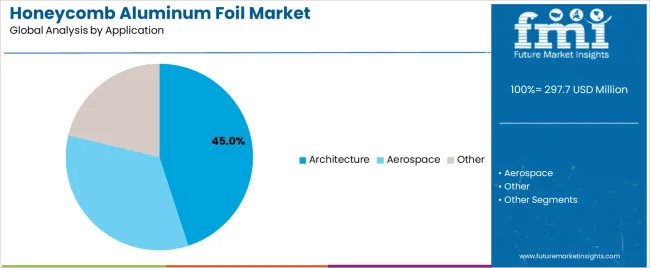
Market Position: Architecture applications command a significant market position with 45% share due to green building requirements and widespread adoption across global construction markets.
Value Drivers: This application segment provides the primary demand source for honeycomb aluminum foils, meeting requirements for lightweight structures, energy efficiency, and sustainable building practices without excessive material complexity or performance variation.
Growth Characteristics: The segment benefits from broad applicability across construction sectors, stringent sustainability specifications, and established building programs that support widespread adoption and operational efficiency.
Aerospace applications capture 40% of the market share due to specialized material requirements in aircraft structures and satellite components. These applications demand high-performance honeycomb foils capable of providing exceptional strength-to-weight ratios while ensuring structural integrity and weight optimization.
Other applications account for 15% of the market share, including automotive components, rail transportation, marine structures, and specialty industrial equipment requiring customized honeycomb foil solutions for operational optimization and application-specific requirements.
| Category | Factor | Impact | Why It Matters |
|---|---|---|---|
| Driver | Green building trends & energy efficiency requirements | ★★★★★ | Growing sustainable construction demands lightweight, recyclable honeycomb foils with consistent quality and thermal efficiency characteristics. |
| Driver | Aerospace industry growth & weight reduction initiatives | ★★★★★ | Expanding aircraft production drives demand for high-performance lightweight materials; suppliers providing certified aerospace-grade foils gain competitive advantage. |
| Driver | Urbanization & infrastructure development | ★★★★☆ | Rapid urban growth requires efficient building materials; demand for lightweight honeycomb structures in curtain walls and panels expanding addressable market. |
| Restraint | Raw aluminum price volatility & cost pressures | ★★★★☆ | Aluminum market fluctuations impact pricing; increases cost sensitivity and margin pressure in competitive markets. |
| Restraint | Complex manufacturing processes & quality control | ★★★☆☆ | Multi-application facilities face stringent processing procedures and quality requirements, limiting operational flexibility and increasing production complexity. |
| Trend | Advanced alloy development & performance enhancement | ★★★★★ | High-strength alloys, improved corrosion resistance, and enhanced formability transform operations; materials innovation becomes core value proposition. |
| Trend | Circular economy & aluminum recycling | ★★★★☆ | Environmental sustainability drives closed-loop recycling programs; recyclable honeycomb foils and waste reduction capabilities differentiate suppliers in conscious markets. |
The honeycomb aluminum foil market demonstrates varied regional dynamics with Growth Leaders including China (5.3% growth rate) and India (4.9% growth rate) driving expansion through construction initiatives and production capacity development. Steady Performers encompass United States (3.7% growth rate), Germany (4.5% growth rate), and developed regions, benefiting from established construction industries and advanced manufacturing adoption. Emerging Markets feature Brazil (4.1% growth rate) and developing regions, where infrastructure initiatives and manufacturing modernization support consistent growth patterns.
Regional synthesis reveals East Asian markets leading adoption through construction expansion and aerospace development, while North American countries maintain steady expansion supported by green building advancement and sustainability standardization requirements. European markets show moderate growth driven by architectural applications and energy efficiency integration trends.
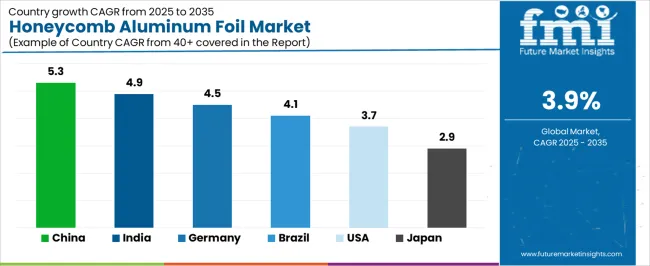
| Region/Country | 2025-2035 Growth | How to win | What to watch out |
|---|---|---|---|
| China | 5.3% | Lead with cost-effective 3XXX alloys | Quality consistency; overcapacity risks |
| India | 4.9% | Focus on construction-grade materials | Infrastructure gaps; project delays |
| Germany | 4.5% | Offer premium aerospace-grade foils | Over-engineering; certification costs |
| Brazil | 4.1% | Value-oriented solutions | Economic volatility; import dependencies |
| United States | 3.7% | Provide sustainability support | Domestic sourcing pressure; labor costs |
| Japan | 2.9% | Push advanced alloy solutions | Market maturity; demographic decline |
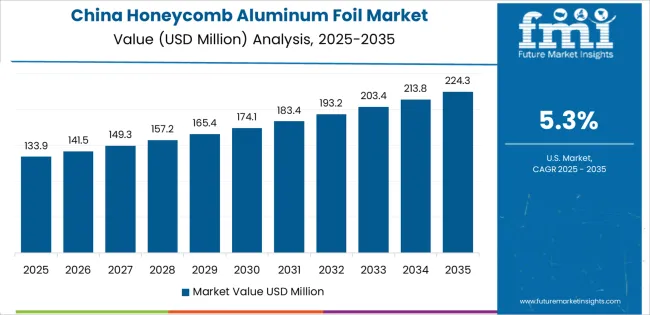
China establishes fastest market growth through aggressive construction programs and comprehensive production capacity development, integrating advanced honeycomb aluminum foils as standard materials in building facade and aerospace manufacturing installations. The country's 5.3% growth rate reflects government initiatives promoting green buildings and domestic materials production capabilities that mandate the use of lightweight honeycomb structures in construction and transportation facilities. Growth concentrates in major urban centers, including Beijing, Shanghai, and Guangzhou, where construction technology development showcases integrated honeycomb foil systems that appeal to developers seeking advanced building optimization capabilities and sustainability management applications.
Chinese manufacturers are developing cost-effective honeycomb foil solutions that combine domestic production advantages with advanced processing features, including enhanced surface treatment and improved dimensional control. Distribution channels through construction materials suppliers and manufacturing distributors expand market access, while government support for sustainable construction supports adoption across diverse architectural and industrial segments.
Strategic Market Indicators:
In Mumbai, Bangalore, and Delhi, construction facilities and manufacturing plants are implementing advanced honeycomb aluminum foils as standard materials for building optimization and sustainability compliance applications, driven by increasing government infrastructure investment and modernization programs that emphasize the importance of lightweight construction capabilities. The market holds a 4.9% growth rate, supported by government smart city initiatives and construction infrastructure development programs that promote advanced lightweight materials for architectural and industrial facilities. Indian operators are adopting honeycomb foils that provide consistent operational performance and energy efficiency features, particularly appealing in regions where construction efficiency and sustainability standards represent critical operational requirements.
Market expansion benefits from growing construction manufacturing capabilities and technology transfer agreements that enable domestic production of advanced honeycomb foils for building applications. Technology adoption follows patterns established in construction materials, where reliability and sustainability drive procurement decisions and operational deployment.
Market Intelligence Brief:
Advanced construction materials market in Germany demonstrates sophisticated honeycomb aluminum foil deployment with documented operational effectiveness in architectural applications and manufacturing facilities through integration with existing quality systems and building infrastructure. The country leverages engineering expertise in materials technology and quality systems integration to maintain a 4.5% growth rate. Industrial centers, including Bavaria, Baden-Württemberg, and North Rhine-Westphalia, showcase premium installations where honeycomb foils integrate with comprehensive building platforms and facility management systems to optimize construction operations and energy effectiveness.
German manufacturers prioritize material certification and EU compliance in honeycomb foil procurement, creating demand for premium materials with advanced features, including sustainability monitoring integration and automated quality systems. The market benefits from established construction materials infrastructure and a willingness to invest in advanced lightweight technologies that provide long-term operational benefits and compliance with international energy efficiency standards.
Market Intelligence Brief:
Brazil's market expansion benefits from diverse construction demand, including building modernization in São Paulo and Rio de Janeiro, infrastructure facility development, and government urbanization programs that increasingly incorporate honeycomb foil solutions for construction optimization applications. The country maintains a 4.1% growth rate, driven by rising construction activity and increasing recognition of lightweight material benefits, including energy efficiency and enhanced structural performance.
Market dynamics focus on cost-effective honeycomb foil solutions that balance advanced material performance with affordability considerations important to Brazilian construction operators. Growing infrastructure development creates continued demand for modern lightweight materials in new building projects and construction modernization initiatives.
Strategic Market Considerations:
United States establishes market leadership through comprehensive green building programs and advanced construction infrastructure development, integrating honeycomb aluminum foils across architectural and aerospace applications. The country's 3.7% growth rate reflects established construction industry relationships and mature lightweight materials adoption that supports widespread use of honeycomb foils in building facilities. Growth concentrates in major construction markets, including California, Texas, and New York, where building technology showcases mature honeycomb foil deployment that appeals to developers seeking proven lightweight capabilities and energy efficiency applications.
American materials providers leverage established distribution networks and comprehensive certification capabilities, including LEED support programs and sustainability assurance that create customer relationships and operational advantages. The market benefits from mature green building standards and construction requirements that mandate honeycomb foil use while supporting materials advancement and operational optimization.
Market Intelligence Brief:
United Kingdom's construction materials market demonstrates established honeycomb aluminum foil deployment with documented operational effectiveness in architectural applications and building facilities through integration with existing quality systems and construction infrastructure. The country maintains a 3.3% growth rate. Construction centers, including London, Manchester, and Birmingham, showcase installations where honeycomb foils integrate with comprehensive building platforms and facility management systems to optimize construction operations and energy effectiveness.
British developers prioritize sustainability compliance and operational efficiency in honeycomb foil procurement, creating demand for materials with advanced features, including carbon footprint tracking and automated quality systems. The market benefits from established construction infrastructure and green building standards that support materials advancement and operational optimization.
Market Intelligence Brief:
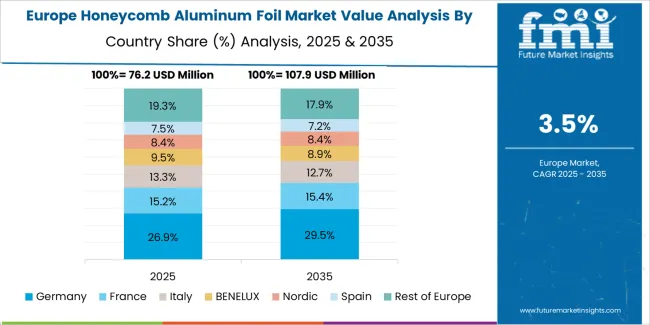
The European honeycomb aluminum foil market is projected to grow from USD 103.1 million in 2025 to USD 210.4 million by 2035, registering a CAGR of 7.4% over the forecast period. Germany is expected to maintain its leadership position with a 35.8% market share in 2025, supported by its advanced construction materials infrastructure and major building manufacturing centers.
United Kingdom follows with a 22.1% share in 2025, driven by comprehensive green building programs and materials technology development initiatives. France holds a 18.4% share through specialized architectural applications and energy efficiency compliance requirements. Italy commands a 12.9% share, while Spain accounts for 10.8% in 2025. The rest of Europe region is anticipated to gain momentum, expanding its collective share from 6.3% to 6.8% by 2035, attributed to increasing honeycomb aluminum foil adoption in Nordic countries and emerging Eastern European facilities implementing construction modernization programs.
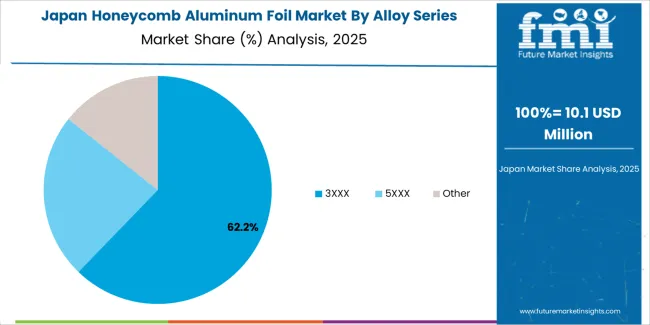
Japan's honeycomb aluminum foil market demonstrates sophisticated deployment with documented operational effectiveness in architectural and transportation applications through integration with existing quality systems and manufacturing infrastructure. The country maintains a 2.9% growth rate, supported by established construction manufacturing operations and premium quality requirements. Manufacturing centers showcase advanced honeycomb foil installations where precision processing capabilities and quality management features align with Japanese material standards and construction quality expectations.
Japanese manufacturers prioritize material reliability and quality compliance in honeycomb foil procurement, creating demand for premium materials with advanced processing features. The market benefits from established quality standards and mature construction infrastructure, though market maturity and demographic challenges moderate growth potential compared to emerging Asian markets.
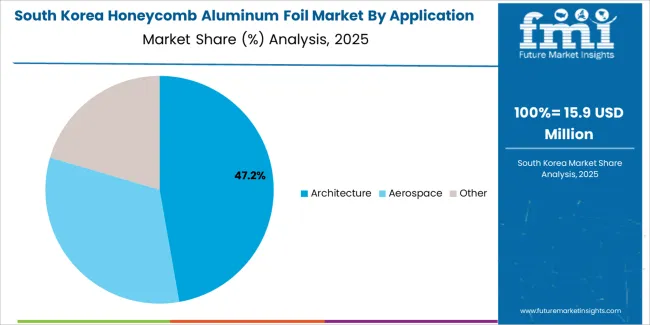
South Korea's honeycomb aluminum foil market demonstrates innovation-focused adoption with emphasis on advanced lightweight materials and sustainability compliance across construction operations. The market maintains steady growth driven by green building initiatives and technology requirements. Construction facilities in Seoul and Busan showcase modern honeycomb foil installations where material capabilities and energy efficiency features support premium building positioning and technology competitiveness in regional markets.
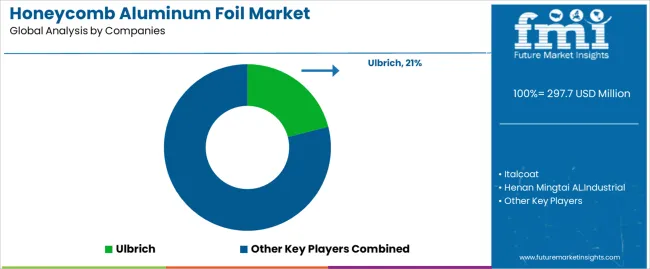
The honeycomb aluminum foil market features 10-12 credible players with top 5 companies holding approximately 65-69% market share by revenue. Leadership is maintained through technical support networks, material certification capabilities, and processing innovation focused on alloy performance, structural properties, and sustainability integration capabilities.
Structure: Market concentration reflects established aluminum manufacturers with proven processing technology and comprehensive technical capabilities. Regional players maintain presence through localized support networks and cost-competitive offerings, while global leaders leverage processing innovation and extensive distribution infrastructure.
Leadership is maintained through: extensive technical support networks, material certification capabilities, and processing innovation emphasizing alloy composition, structural integrity, surface quality, and digital monitoring integration.
What's commoditizing: standard 3XXX alloy grades and basic processing techniques face increasing price pressure as materials technology matures and alternative suppliers emerge with comparable performance specifications.
Margin Opportunities: technical support services, custom processing assistance, and integration into customer workflows including material certification, sustainability documentation, and application development programs provide differentiation beyond materials sales.
| Stakeholder | What they actually control | Typical strengths | Typical blind spots |
|---|---|---|---|
| Global platforms | Distribution reach, deep product catalogs, certification support | Broad availability, proven reliability, multi-region support | Processing innovation cycles; customer dependency |
| Technology innovators | R&D capabilities; advanced alloy processing; clean material interfaces | Latest alloys first; attractive ROI on premium applications | Technical support density outside core regions; customization complexity |
| Regional specialists | Local compliance, fast delivery, nearby technical support | Close to site support; pragmatic pricing; local regulations | Technology gaps; talent retention in technical service |
| Service-focused ecosystems | Custom processing support, sustainability assurance, material availability | Lowest implementation risk; comprehensive support | Service costs if overpromised; material obsolescence |
| Niche specialists | Specialized applications, custom alloys, R&D support | Win specialty/aerospace; flexible solutions | Scalability limitations; narrow market focus |
Market dynamics favor materials providers demonstrating comprehensive sustainability capabilities, rapid technical support networks, and proven integration with existing construction and aerospace processes. Materials advancement focuses on structural performance through advanced alloy control, digital monitoring for quality assurance, and seamless compatibility with building management systems. Competitive differentiation increasingly relies on technical service capabilities and sustainability features rather than basic material specifications.
| Item | Value |
|---|---|
| Quantitative Units | USD 297.7 million |
| Alloy Series | 3XXX, 5XXX, Other |
| Application | Architecture, Aerospace, Other |
| Regions Covered | North America, Latin America, Western Europe, Eastern Europe, East Asia, South Asia Pacific, Middle East & Africa |
| Countries Covered | China, India, Germany, Brazil, United States, United Kingdom, Japan, South Korea, and 15+ additional countries |
| Key Companies Profiled | Ulbrich, Italcoat, Henan Mingtai AL.Industrial, Yong Jie New Material, GuiZhou Chalco Aluminum, Jiangsu Dingsheng New Energy Materials |
| Additional Attributes | Dollar sales by alloy series and application categories, regional adoption trends across East Asia, South Asia Pacific, and Western Europe, competitive landscape with aluminum materials manufacturers and specialty foil suppliers, developer preferences for structural performance control and material sustainability, integration with construction platforms and quality monitoring systems, innovations in alloy technology and processing enhancement, and development of advanced honeycomb aluminum foil solutions with enhanced performance and construction optimization capabilities. |
The global honeycomb aluminum foil market is estimated to be valued at USD 297.7 million in 2025.
The market size for the honeycomb aluminum foil market is projected to reach USD 436.4 million by 2035.
The honeycomb aluminum foil market is expected to grow at a 3.9% CAGR between 2025 and 2035.
The key product types in honeycomb aluminum foil market are 3xxx , 5xxx and other.
In terms of application, architecture segment to command 45.0% share in the honeycomb aluminum foil market in 2025.






Full Research Suite comprises of:
Market outlook & trends analysis
Interviews & case studies
Strategic recommendations
Vendor profiles & capabilities analysis
5-year forecasts
8 regions and 60+ country-level data splits
Market segment data splits
12 months of continuous data updates
DELIVERED AS:
PDF EXCEL ONLINE
Honeycomb Core Materials Market Size and Share Forecast Outlook 2025 to 2035
Competitive Overview of Honeycomb Packaging Market Share
Honeycomb Packing Paper Market Analysis – Growth & Trends 2024-2034
Paper Honeycomb Market Size and Share Forecast Outlook 2025 to 2035
Aramid Honeycomb Core Material Market Size and Share Forecast Outlook 2025 to 2035
Bonding Honeycomb Vibration Isolation Platform Market Size and Share Forecast Outlook 2025 to 2035
Aluminum Honeycomb Panels Market Size and Share Forecast Outlook 2025 to 2035
Aluminum Alloy Sacrificial Anode Market Size and Share Forecast Outlook 2025 to 2035
Aluminum Foam Market Size and Share Forecast Outlook 2025 to 2035
Aluminum Cap & Closure Market Forecast and Outlook 2025 to 2035
Aluminum Casing of the Blade Battery Market Size and Share Forecast Outlook 2025 to 2035
Aluminum ROPP Closure Market Size and Share Forecast Outlook 2025 to 2035
Aluminum Cans Market Size and Share Forecast Outlook 2025 to 2035
Aluminum Pouches Market Size and Share Forecast Outlook 2025 to 2035
Aluminum-Free Food Pouch Market Size and Share Forecast Outlook 2025 to 2035
Aluminum-Nickel Catalyst Market Size and Share Forecast Outlook 2025 to 2035
Aluminum Frame Monitors Market Size and Share Forecast Outlook 2025 to 2035
Aluminum Composite Materials Market Size and Share Forecast Outlook 2025 to 2035
Aluminum Coated Thermal Protective Clothing Market Size and Share Forecast Outlook 2025 to 2035
Aluminum Flat Products Market Size and Share Forecast Outlook 2025 to 2035

Thank you!
You will receive an email from our Business Development Manager. Please be sure to check your SPAM/JUNK folder too.
Chat With
MaRIA